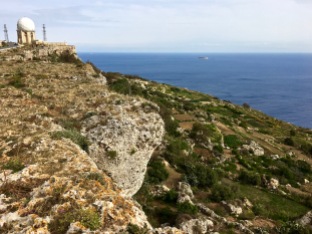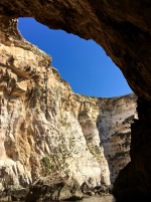
April 24, 2017. For the nature lovers in the crowd, today I’ll be focusing on Malta’s alfresco options. The place is made for hiking, biking, swimming — and movie making. Whether you know it or not, you’ve probably seen some of the islands’ most stunning settings courtesy of ads, television, and films like Troy, The DaVinci Code, Captain Phillips, Gladiator, and too many to mention here.

The lure is the eerily azure waters set against a backdrop of rugged limestone cliffs and evocative ancient buildings that poke up out of the stark landscape. In places, the terrain feels so alien that you’ll wonder whether you’ve wandered into a stage set from Star Wars or some other sci-fi movie. But even if you’re not a camera buff or into into sporty stuff, you’ll still enjoy a walk along the shoreline for stage-set vistas that clear your mind and put everything into perspective.
With our limited time and the unseasonably chilly Easter weather, Matthew and I barely scratched the surface of all the outdoor experiences Malta has to offer. But what we saw made us hanker for more, so take a look at our recommendations….

Dwera Bay
I opened this post with a photo (up top) of the now-collapsed Azure Window, a natural arch that sat in Dwera Bay until March of this year, when a tremendous storm washed it away. But just because the arch has bid Malta adieu doesn’t mean that there’s nothing more to see along this stretch of coastline. Matthew and I were knocked senseless by the view. A vast expanse of sand-colored stone spread out before us, like something out of Lawrence of Arabia. Cliffsides formed an imposing fortress that stood sentry over a barren, craggy beachfront where wind and water had tortured and twisted the rock into Dali-esque shapes. Harsh beauty.

Closer examination showed that petrified sand dollars made up much of the ground around us. Here and there, little sulfurous-looking puddles marked the only signs of life — tidal pools filled with bits of seaweed and a few living relatives of the fossilized creatures frozen in stone nearby. A short walk across the beach led to an emerald green pond where divers bobbed in the water as they tested their equipment. The pool is the entry point to “The Blue Hole,” a famous scuba spot next door to the Azure Window. Yep, Dwera has something for everybody, whether you want to “swim with the fishes” or just spend the day scrambling over the rocks and admiring the power of nature. Bonus, it’s on the island of Gozo, a short drive from the Ġgantija Prehistoric Temple Complex that I wrote about earlier.



Ghar Lapsi
The day that we visited Ħaġar Qim and Mnajdra’s prehistoric temples, we took an hour to swing by Ghar Lapsi, the most picturesque swimmin’ hole you can imagine. Its dazzling blue-green waters are so clear that you can look down and see schools of fish cavorting along the sea floor. And for those of you who like to float without the fear of getting swamped by a rogue wave, a reef wall protects the natural cove from rough seas. Although Ghar Lapsi doesn’t have much of a beach, it does offer a concrete pier and a little spit of rock for sunbathing. Snorkelers and divers love the pool, too, as a great spot for spying rays, eels, and seahorses. Not to mention that there’s an excellent fish restaurant and bar right on site.

The Dingli Cliffs
As I’ve mentioned earlier, much of Malta is treeless, rocky, and quite arid. Freshwater is in short supply, so drinking water comes from reverse osmosis of seawater. But that doesn’t mean the islands are completely lacking in green. Places like the Dingli Cliffs are blanketed in a knee-high garden of wildflowers, herbs, and fragrant shrubs, collectively called garrigue. We visited late in the day, just before the sun set and as a storm was rolling in. Not an optimal time for a hike, but we made the most of it.

The cliffs themselves form the highest point on Malta, with an elevation of roughly 850 feet (250 meters) above sea level. A walking path treads the edge of the precipice, meant that, although it’s a level and easy trail, the wind can be pretty ferocious. As usual, Matthew tempted fate by posing on every frail-looking promontory, just to give me a thrill. Whereas I occupied my acrophobic self with examining the incredibly diverse carpet of tiny blossoms clinging to the rock face. Irises no bigger than my thumb and morning glories the size of quarters waved at me from their fragile perches. Guess they gotta be small and sturdy to survive the hot sun, high winds, and lack of topsoil and moisture here.

The Blue Grotto
We’d read all about the famously glowing waters of The Blue Grotto. They supposedly owe their luminous quality to a combination of phosphorescent sea life and the location of the limestone caves themselves, which catch the morning light and mirror it back. We’d been warned that, to see the effect — and to avoid the rough seas that kick up in the afternoon — you must venture out early, before 1:00 p.m. So we heeded our guidebook’s advice and arrived in the tiny fishermen’s harbor of Wied iż-Żurrieq at about 8:30 a.m., just as the boats were being hauled into the water.

The “excursion vessels” surprised me. Barely bigger than dinghies, they offered seating for maybe eight skinny people, including the fisherman himself. Each came equipped with a small outboard motor, but no oars, which would have seemed more fitting for such bathtub-sized boats. As I watched the ocean waves pound the shoreline, I noted that every vessel sported a single pole that skewered a stack of puny-looking life vests. I gulped and fingered the tab of Dramamine in my pocket, wondering if I should take it merely for the sedative effect. Despite all my years of bass fishing with my father, I’ve never really gotten over my fear of water or my predilection for seasickness.

To distract ourselves while we waited for a full boatload of customers to arrive, we browsed the nearby souvenir stall and café. Big mistake. One wall of the place was plastered with posters telling the story of the Great White shark that had been caught just offshore. Photos of the toothy beast and vitals stats listing it at 23 feet long (7 meters) and 2,700 kilos (almost 6,000 pounds) weren’t terribly reassuring. Visions of our tiny dory being capsized by one of these behemoths made us both consider bailing on the entire idea.

We tried to console ourselves that it’d been 30 years since the shark’s capture, so maybe it was a one-of incident. But as we boarded the boat and the captain fired up his little mosquito of a motor, I couldn’t get the opening strains of the “Jaws” soundtrack out of my head. Taking note of the other passengers — an elderly German couple and a French family with a young boy — Matthew joked, “well, at least there’ll be some smaller, slower chum in the water; that’ll give us a chance to swim for it.” He always knows how to cheer me up.

Our peapod of a vessel slowly chugged out of its sheltering inlet and into the buffeting wind. Tossing like flotsam atop the whitecaps, the little boat struggled to make headway, and few times I feared we might get swamped. To take my mind off our imminent death, I tried to focus on the unusual scenery surrounding us. Lumps of pockmarked limestone oozed out into the sea. In places, caves and natural arches perforated steep cliffs as a testimony to the sea’s sculpting talents. From this angle, the whole island looked like a termite mound of Goliath proportions. Every now and then, an ancient stone watchtower protruded up out of the landscape to put things back into human scale.




Our captain clung to the coastline as we doggedly made our way towards a collection of shadows along the cliff face. “Cats’ Cave!” he called out, pointing to a depression in the rock face that, as legend says, was once home to a family of white cats. “Small Fifla Cave!” he yelled, nodding to a different opening that sported a rock formation shaped like the neighboring table-topped island. Both of these we passed by, due to the choppiness of the water. And frankly, I was fine with that, as all the crashing and splashing made me fully aware of why Blue Grotto trips often get cancelled, and why Malta offers a welcome harbor in the midst of notoriously rough seas.

But eventually we made it to one of the caverns large enough for the boat to safely negotiate. “Reflection Cave,” our captain announced, as we approached. The sun’s rays rendered the ocean floor an odd turquoise, like the bottom of a swimming pool. Purple encrustations of limpets lining the waterline along the cavern walls hinted at some of the phosphorescent sea life that contributes to the unearthly vibrant color. Once fully inside the dark recess, we watched the play of light against the ceiling and came to understand how the cave had earned its name.



A short trip brought us to our next site, two natural arches, one of which soared high over our heads as we “threaded the needle” into the official Blue Grotto. Here, the water’s color changed to an oddly luminous teal. The mouth of the cave seem lit from below, and I had the feeling that something glowingly alien was about to rise up from the ocean’s depths. We sat suspended over the show for awhile, adjusting to the darkness and admiring how the light turned the rock walls into gleaming chunks of amethyst and malachite. With the plop-plop of water dripping from the cave ceiling, and the gentle lapping of waves against the walls, the experience was almost primordial.

But of course, our last stop brought us to the bumpiest part of our cruise, Honeymoon Cave — so named for an island newlywed tradition involving a boat trip to the cavern for dinner on Picnic Ledge and a swim through the rectangular arch known as “The Blue Window.” Listening to the strong slap and surge of the surf here made me wonder how many marriages never made it past this moment. Leave it to me to think of worst-case scenarios in the middle of a romantic (though mildly terrifying) setting.
I know it sounds like didn’t have a good time. And I’ll admit that I endured some stomach drops and heart palpitations. Check out my video here, and look for the priceless expression on my face. But the experience was totally worth it, despite my abject terror. There’s an old adage that says danger enhances beauty, and the Blue Grotto trip proves the point.
That’s all for now about Malta’s outdoor wonders — tomorrow, we’re on to travel tips.
PS — A huge “thank you!” to my niece, McKenna, who edited the video and added music for me — you’re awesome!!
























